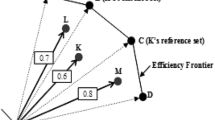Abstract
Conventional data envelopment analysis (DEA) models make the assumption of non-negativity and real values in the input and output of the systems that are under study. This paper combines these two interrelated ideas. One is the non-radial measurement of efficiency by establishing an aggregate directional distance formulation of the DEA model (ADDM). Another is the introduction of an integer directional distance function. Usually, directional distance formulations of DEA and ADDM projections of efficient targets for inefficient decision making units (DMUs) have non-integer values. In this paper directional distance function is modified and a mixed integer directional distance formulation of DEA is proposed. This model guarantees integer targets for inefficient DMUs and is applicable to measure efficiency even when input and output variables are negative integer values.


Similar content being viewed by others
References
Banker, R. (1993). Maximum likelihood, consistency and data envelopment analysis: A statistical foundation. Management Science, 39(10), 1261–1264.
Banker, R., Charnes, A., & Cooper, W. W. (1984). Some models for estimating technical and scale efficiencies in data envelopment analysis. Management Science, 30(9), 1078–1092.
Banker, R., & Morey, R. (1986). The use of categorical variables in data envelopment analysis. Management Science, 32(12), 1613–1627.
Chambers, R. G., Chung, Y., & Färe, R. (1996). Benefit and distance function. Journal of Economic Theory, 70, 407–419.
Chambers, R. G., Chung, Y., & Färe, R. (1998). Profit directional distance functions and Nerlovian efficiency. Journal of Optimization and Theory and Applications, 12, 233–247.
Charnes, A., Cooper, W. W., & Rhodes, E. (1978). Measuring the efficiency of decision making units. European Journal of Operational Research, 2(4), 429–444.
Chung, Y. H., Färe, R., & Grooskopf, S. (1997). Productivity and undesirable outputs: A directional distance function approach. Journal of Environmental Managements, 51, 229–240.
Cooper, W. W., Park, K. S., & Pastor, J. T. (1999). RAM: A range adjusted measure of inefficiency for use with additive models and measures in DEA. Journal of Productivity Analysis, 11, 5–42.
De Borger, B., Ferrier, G. D., & Kerstens, K. (1998). The choice of technical efficiency measure on the free disposal hull reference technology: A comparison using US banking data. European Journal of Operational Research, 105, 427–446.
Diabat, A., Shetty, U., & Pakkala, T. P. M. (2015). Improved efficiency measures through directional distance formulation of data envelopment analysis. Annals of Operations Research, 229(1), 325–346.
Emrouznejad, A., Anouze, A. L., & Thanassoulis, E. (2010a). A semi-oriented radial measure for measuring the efficiency of decision making units with negative data, using DEA. European Journal of Operational Research, 200, 297–304.
Emrouznejad, A., Amin, R. A., Thanassoulis, E., & Anouze, A. L. (2010b). On the bounedness of the SORM DEA models with negative data. European Journal of Operational Research, 206, 265–268.
Emrouznejad, A., & De Witte, K. (2010). COOPER-frameork: A unified process for non-parametric projects. European Journal of Operational Research, 207, 1573–1586.
Färe, R., & Grosskopf, S. (2000). Theory and application of directional distance function. Journal of Productivity Analysis, 13, 93–103.
Färe, R., & Grosskopf, S. (2010). Directional distance functions and slack-based measures of efficiency. European Journal of Operational Research, 200, 320–322.
Färe, R., & Lovell, C. A. K. (1978). Measuring the technical efficiency of production. Journal of Economic Theory, 19(1), 150–162.
Färe, R., Grosskopf, S., & Lovell, C. A. K. (1985). Measurement of efficiency of production. Dordrecht: Kluwer-Nijhoff Publishing.
Fukuyama & Weber (2009). A directional slacks-based measure of technical inefficiency. Socio-Economic Planning Sciences, 43, 274–287.
Kamakura, W. (1988). A note on the use of categorical variables in data envelopment analysis. Management Science, 34(10), 1273–1276.
Kuosmanen, T., & Matin, Kazemi. (2009). Theory of integer valued data envelopment analysis. European Journal of Operational Research, 192, 658–667.
Lozano, S., & Villa, G. (2006). Data envelopment analysis of integer valued inputs and outputs. Computers and Operations Research, 33, 3004–3014.
Luenberger, D. G. (1992). Benefits, functions and duality. Journal of Mathematical Economics, 21, 461–481.
Matin, K., & Kuosmanen, T. (2009). Theory of integer valued data envelopment analysis under alternative returns to scale. Omega, 37, 988–995.
Pastor, J. T., Ruiz, J. L., & Sirvent, I. (1999). An enhanced DEA Russell graph efficiency measure. European Journal of Operational Research, 115, 596–607.
Rousseau, J., & Semple, J. (1993). Categorical outputs in data envelopment analysis. Management Science, 39(3), 384–386.
Scheel, H. (2001). Undesirable outputs in efficiency valuations. European Journal of Operational Research, 132(2), 400–410.
Sharp, J. A., Meng, W., & Liu, W. (2007). A modified slacks based measure model for data envelopment analysis with natural negative outputs and inputs. Journal of the Operational Research Society, 58, 1672–1677.
Silva Portela, M. C. A., Thanassoulis, E., & Simpson, G. (2004). Negative data in DEA: A directional distance approach applied to bank branches. Journal of the Operational Research Society, 55, 1111–1121.
Watanabe, M., & Tanaka, K. (2007). Efficiency analysis of Chinese industry: A directional distance approach. Energy Policy, 35, 6323–6331.
Acknowledgments
Youchao Tan’s research is partially supported by National Natural Science Foundation of China, Grant no 71302005, humanities and social sciences Foundation of Ministry of Education in China, Grant no 14YJC630049.
Conflict of interest
None.
Author information
Authors and Affiliations
Corresponding author
Rights and permissions
About this article
Cite this article
Tan, Y., Shetty, U., Diabat, A. et al. Aggregate directional distance formulation of DEA with integer variables. Ann Oper Res 235, 741–756 (2015). https://doi.org/10.1007/s10479-015-1891-8
Published:
Issue Date:
DOI: https://doi.org/10.1007/s10479-015-1891-8




